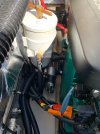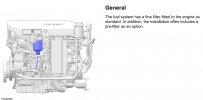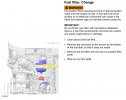Johnatkatys
RT25-SC
- Joined
- Jul 30, 2023
- Messages
- 32
- Location
- Port Ludlow, WA
- Fluid Motion Model
- R-25 SC
- Hull Identification Number
- FMLR2512I617
- Vessel Name
- Adagio
- MMSI Number
- 338490387
Model Year: 2017, Vessel: RT25 SC, Volvo Penta D3
The fuel line beneath the fuel filter broke and the engine compartment quickly flooded. We pumped out 45 gallons of diesel. Wish I'd taken a picture, but it was a rough day.
For some reason the bilge pumps never ran. Good thing - that would have been a real mess.
So here's the question: What parts might be vulnerable to this?
Here's what we have so far:
-- alternator - could that survive?
-- serpentine belt - easy to replace
-- bilge pumps - were they already failed, or did they fail fast?
-- engine oil - if diesel leaked down the tube
-- air intake filter - there was a lot of foam
What's missing?
The fuel line beneath the fuel filter broke and the engine compartment quickly flooded. We pumped out 45 gallons of diesel. Wish I'd taken a picture, but it was a rough day.
For some reason the bilge pumps never ran. Good thing - that would have been a real mess.
So here's the question: What parts might be vulnerable to this?
Here's what we have so far:
-- alternator - could that survive?
-- serpentine belt - easy to replace
-- bilge pumps - were they already failed, or did they fail fast?
-- engine oil - if diesel leaked down the tube
-- air intake filter - there was a lot of foam
What's missing?



